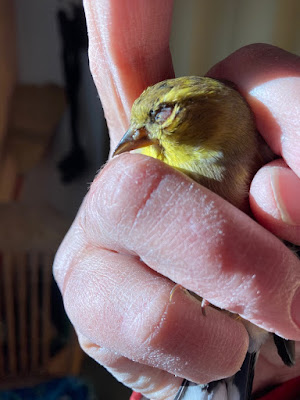Goldfinch Hospital: The 2021 Mycoplasma Outbreak
Monday, March 8, 2021
It's March 8, and I have just caught, by hand, my eighth American goldfinch for treatment for Mycoplasma gallinae infection. This is the disease my blue jay Jemima had, for which I treated her successfully, and wrote about in Saving Jemima: Life and Love with a Hard-luck Jay.
(Yes, that's a link, because I'm selling signed copies off my website now, whee!)
But I'm going to take you back to February 21 for my first patient's story. This was the first goldfinch I found that succumbed to the disease, and I tried to catch her for at least a week, but she was too quick for me. I sneak up on the bird quietly and slowly and snatch it with my hand, either from the perch on the tube feeder or from the ground. This one was so cagey she had to be completely blind and sitting in the snow on a subfreezing day for me to finally grab her. By then, she was skin and bones, and she didn't make a peep when my hand finally closed around her.
Little did I know what would unfold from there.
Mycoplasma, or house finch disease, affects more than 30 other species of wild birds. It started off with domestic poultry, and Eastern house finches first caught it in 1994. Because the Eastern population of house finches is terribly inbred, all being descended from one release event at JFK Airport in 1939, our house finches have little to no resistance to the pathogen. (Western birds apparently do!). Mycoplasma causes conjunctivitis that is painful and which, in the space of a few days, can rob the bird of its eyesight. That's when I creep in and make my grab.
This is the worst Mycoplasma spring I've ever experienced. Hey, why not? Pandemics are the thing. Seriously, though, I suspect that the bitter cold and snow cover that hung in here in Ohio for about three weeks may have caused otherwise healthy birds to succumb to the germ, which is everywhere in the environment, but especially concentrated around OUR FEEDING STATIONS. Yep, humans are behind this, as we are behind almost all of the mishaps that befall wild birds.
Look at this: Humans keep domestic fowl in crowded quarters so they often get sick, and poor husbandry allowed the disease to pass on to wild birds. Humans kept house finches as pets before passage of the Migratory Bird Treaty Act, importing them from California to pet shops in New York. And it was humans who released a shipment of house finches, and caused them to spread throughout the East. Our feeders encouraged the wildfire spread of this American native (but exotic-to-the-East) species. Because of inbreeding depression, these Eastern finches have no resistance to new pathogens. And what do we do? Keep feeding them; create concentration points for unnatural numbers of wild birds. Yes, it's our feeders that encourage the spread of Mycoplasma to more than 30 species of wild birds. (I'm looking out at my one freshly bleached tube feeder, kept full of seed for the express purpose of catching sick goldfinches, and I see three more goldfinches and one house finch out there with goopy eyes). I'm caught in a whirlpool here, trying to remove all the sick birds from this enormous flock of 60 plus birds, disinfecting and raking...tending cages...arrgh. It's a lot. Hence no blogposts for almost a month. But on with the story...
First stop for a completely blind bird is my hand, with a dropper of Tylan-laced water, which they guzzle down eagerly. That sets them on the road to recovery. This bird is drinking from a little pool of Tylan water on my knuckle. (I can't administer the medicine and make a video at the same time).
Then they are confined in a small plastic Critter Keeper, with shallow dishes of food and water that the bird can feel underfoot. Almost all of them begin to eat and drink on their own; they're starved and very thirsty by the time I am able to catch them. Generally, within 24 hours, the stuck-shut swollen eyes show marked improvement and the bird regains at least some its sight. Some need force-feeding and more droppers of Tylan for a couple of days before they can see well again and are strong enough to make it in the larger cage.
Once they're sighted and eating on their own, they go to one of two larger cages I've got set up. One is in my foyer, and one is back in Liam's room. (sorry, Liam; I put a dropcloth down!) Both face out toward windows so they can see where they are going once they're better. I think that giving them hope of returning to the wild is so important in wildlife rehab. I hate to see creatures kept in dark, shrouded quarters, even as I understand that in a busy clinic, that can be the only choice.
I keep the side toward the window clear, but I use a tablecloth to cover three sides of the cage facing into the house. This works very well. The birds swiftly associate the blank cloth with safety, and don't panic and flutter against the bars when they hear me walk by. I can service the cage once a day, replacing food and Tylan water and changing the papers, and then leave them in peace until the next morning.
Ideally, I'd have nylon-sided caging, but this is what I have, and it works pretty well.
In this video, the Feb. 21 bird has dislodged her cage cover and freaks out when Curtis and I come up the stairs first thing in the morning. It's hard to believe this wildly fluttering creature is the same bird I picked up off the snow, only four days later. Oh, the miracle drug Tylosin does a beautiful job on Mycoplasma.
Soon I had more birds than I could handle in the foyer cage, so I had to get the stepladder and retrieve a second, larger cage from the rafters of the garage, where Bill had stuck it years and years ago. I was thrilled to find it intact and needing only a good scrubbing to go back into service. Here's the first cage, before I got the second set up.
Now, before y'all go rushing out to try to find Tylan and set up your own goldfinch hospital, there are some things you need to know. First, Tylan is available by prescription only. Second, it's expensive--my little 6 oz. bottle of powder cost an eye-popping $75.00. Third, and most important, you have to know what you're doing, and have licenses, both state and federal, to take in, handle and treat migratory birds. I've got those permits. And fourth--you have to keep the birds on Tylan for 21 days. Trust me--it's an eternity to have to feed, water, clean up after and listen to that many birds for three weeks.
And no. You absolutely cannot put Tylan in your bird bath and try to treat the world. Tylan-laced water has to be the bird's ONLY water source, so it won't work because your feeder birds can get water elsewhere; you have to change it every three days; and the likelihood that they'll hang around for three solid weeks is very low; and healthy wild birds absolutely don't need a strong medication. And we really hugely don't need to encourage a drug-resistant variant of Mycoplasma to develop out there. This one is bad enough! And no, this is NOT the same germ that you may have heard is causing a lot of finch deaths in the West: that is salmonellosis. Birds with salmonellosis are lethargic and puffed up and sneezy, but they don't get swollen eyes and go blind the way Mycoplasma-infected birds do.
I am being very explicit here so I won't have so many questions to answer in the comments section. My time and answers are necessarily short this spring, because caring for eight goldfinches takes a lot out of me. But oh, the rewards. In my next post, I'll tell you the story of one of my patients who will touch your heart:
Patio Finch.
|
Widget for blogger by Way2Blogging | Via Spice Up Your Blog Gadgets
|











12 comments:
Eagerly awaiting a Patio visit!
The loving work you do is one of the best and kindest balances to the times we're living in. Thank you.
Excellent post, but a question. Yes inbreeding depression has resulted in a genetically homogenous eastern population of House Finches, but Goldfinches are indigenous and genetically diverse but have suffered badly this year. Hopefully, natural selection will be working and eliminate the genetic variant found in the weak birds and in subsequent years fewer Goldfinches will succumb.
Timely! I saw a Goldfinch at a feeder today. I could go right up to it and that's when I noted the eye issue but didn't think I could help it. It saddened me. Now I know...thank you! Thanks for all you do!!!! I will study this blog and see if I can help.
So, should I discontinue my bird feeders?
So, should I discontinue my bird feeders?
Andrea, yes, discontinue your feeders if you see any birds with bad eyes. Just take them away for a month or so, then bleach well. I saw this a few times using tube feeders, and I just don't use them anymore -- only suet, and only in the winter. I'm trying to do the other things -- provide clean water, lots of the right plants, coverage with brush piles, etc. I don't see as great a variety of birds, but I haven't seen an unhealthy one in years.
Thank you for all you are doing to help these birds, Julie!
Bless you for your kindness to these sweet creatures. ❤
Saw this article. Am thinking I should take my feeders down ....for 6 weeks??
Your thoughts? https://www.smithsonianmag.com/smart-news/songbirds-are-spreading-deadly-disease-birdfeeders-180977222/?fbclid=IwAR3kmwv_2pK4cTmff7aiD7xSXE8uED4J5kzdlS25osA4qoy3K-shpwLcdwg
@Gerry, it's hard for me to answer your question, if it is a question, because I don't know where you live. My blogpost is not about the salmonella outbreak that is affecting the West. I live in Ohio, and I'm dealing with Mycoplasma, another different bacterium. That said, taking feeders down seems to be the best thing to do when you see sick birds at your feeders!
I'm in Wisconsin. I have found your post because I haven't seen any Goldfinches this year and it's June 2021. Highly unusual. I had Goldfinches flying into my windows last year in twos and threes and I didn't look at their eyes but they died immediately. I am going to take down all my feeders today. I am saddened I, but now I have this knowledge I feel compelled to spread the knowledge. Thank you for your warm hearted care of our wildlife. Jayne.
Post a Comment